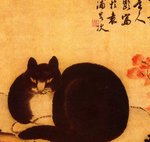This is cool: in a recent Slate-hosted blog post, two professors of English literature make the case that J.R.R. Tolkien, not Orwell, made the best literary depiction of the modern surveillance state. (Hat tip: Patrick Nielsen Hayden, of Making Light.)
« Tolkien’s most potent and intimidating image of centralized surveillance, the Eye of Sauron atop a tower, taking in the whole world, has resonated with those who are paranoid about government monitoring. But it’s Sauron’s vulnerability that has the most relevance for America today. »
And for any country in the world that cares about actual, effective safety for its citizens, not the appearance of such. Because we all know how the book ended: Sauron’s near-absolute surveillance was defeated in the end, by « a small group of dedicated subversives willing to sacrifice their lives », who
« slip in under the surveillance system of a great power, blend in with [its] population, and deliver a devastating blow […]. Far from being covert, much of this operation is conducted in plain sight, with the great power aware of its enemies’ existence, if not their intent. » (The Eye of Sauron is the modern surveillance state », by David Rosen and Aaron Santesso)
My emphasis. Because in our world as on Middle-earth, all seeing is not all knowing. In fact, the more information you amass, the harder it is to parse through it. Meta-data may contain enough information to pinpoint an individual in time and space, to reveal their politics and their sex life, but how do you know which set of data is relevant to national security in the first place? In the book, Frodo and Sam rely on their very insignificance, this state of « visible anonymity » of the needle in the haystack, to travel through Mordor, and even when they encounter a patrol of Orcs, they are seen but not discovered, because they look like just two more denizens of Sauron’s empire. As long as they don’t use the Ring, they are in effect invisible.

Tolkien’s cover design for his Fellowship of the Ring: the Eye of Sauron and the Rings of Power. (Source; Wikimedia)
By an interesting little coincidence, J.R.R. Tolkien effectively finished the redaction of The Lord of the Rings in 1949, the same year as George Orwell published his 1984. Both authors lived in an era marked by the rise of the Soviet Union and the Third Reich, and both had experience of war-time censorship within England itself. The same generation produced also such writers as Aldous Huxley (Brave New World) and Arthur Koestler. Not to mention Russian author Yevgueny Zamyatin, whose science fiction novel We closely prefigures 1984.
But when it came out in 1954, Tolkien’s book looked at first glance like escapist fantasy, a book for adolescents and dreamers. Too bad: he used his « secondary creation » (a phrase he coined, by the way) as a means to explore the same phenomenon: the accumulation of power into the hands of a tyrant, on a scale never ever achieved before in the history of humanity, thanks to technology. And his depiction of Sauron’s evil empire captures both the terror of living under a totalitarian regime, and the inherent flaws of such a regime, where paranoia at the top breeds distrust and inefficiency all down the line. It’s a very human nightmare, for all the Orcs and trolls and evil wizards and giant spiders that inhabit it!











